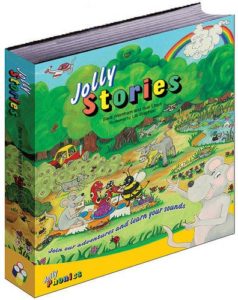
When I first began teaching, I taught phonics using Jolly Phonics. While it isn’t a product I still use, I know lots of others do. So, today, I want to share a key tip a mentor teacher gave to me one day: The Jolly Phonics stories are what brings it all together. On the basis of her experience and depth of knowledge, I went out and purchased the Jolly Stories book, and I think she’s right.
One of the problems with Jolly Phonics, is that a lot of the vocabulary they use in the course isn’t really all that meaningful to very young learners in non-English speaking countries. For example, for the letter T, the TPR action is to turn your head from left to right as if watching a tennis match. Tennis, however, isn’t a game that is very recognisable to children in countries like Vietnam, Thailand or Taiwan. Similarly, the TPR action for the letter ‘p’ is puffing out a candle. While children can learn to attach relatively meaningless TPR to a letter sound, its better you don’t do that.
In that sense, the two-page ‘stories’ in the Jolly Phonics book, help to give the vocabulary meaning and context, and are a good support if you’re using Jolly Phonics in your classroom.

